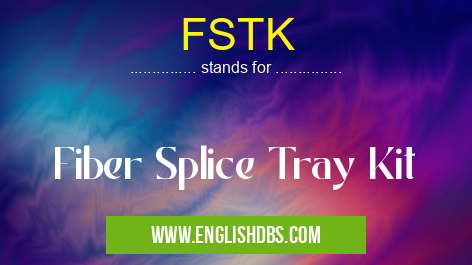What does FSTK mean in UNCLASSIFIED
FSTK stands for Fiber Splice Tray Kit. It is a type of telecommunication equipment used in the installation and maintenance of fiber optic cable networks. FSTK is designed to provide a secure and organized way to splice and store fiber optic cables within a telecommunications enclosure or rack.

FSTK meaning in Unclassified in Miscellaneous
FSTK mostly used in an acronym Unclassified in Category Miscellaneous that means Fiber Splice Tray Kit
Shorthand: FSTK,
Full Form: Fiber Splice Tray Kit
For more information of "Fiber Splice Tray Kit", see the section below.
Components of an FSTK
An FSTK typically consists of the following components:
- Splice tray: A plastic or metal tray that holds and protects fiber optic splices.
- Splice sleeves: Small tubes that are used to align and protect fiber optic strands during splicing.
- Heat shrink tubing: A type of tubing that is used to seal and protect splices from environmental factors.
- Fiber optic connectors: Used to terminate fiber optic cables and connect them to other devices.
- Cable management accessories: Such as cable ties, clips, and strain relief devices, to secure and organize cables within the tray.
Types of FSTKs
There are various types of FSTKs available, each designed for specific applications. Some common types include:
- Single-sided FSTK: Designed to hold fiber optic splices on one side of the tray.
- Double-sided FSTK: Designed to hold fiber optic splices on both sides of the tray.
- High-density FSTK: Designed to accommodate a large number of fiber optic splices in a compact space.
- Modular FSTK: Designed to allow for the addition of additional splice trays as needed.
Benefits of Using FSTKs
FSTKs offer several benefits for fiber optic network installations, including:
- Protection: They provide a robust enclosure to protect fiber optic splices from physical damage, dust, and moisture.
- Organization: They help keep fiber optic cables organized and easy to manage within enclosures.
- Modularity: They allow for the easy addition or removal of splice trays as needed.
- Flexibility: They are available in various sizes and configurations to suit different applications.
Essential Questions and Answers on Fiber Splice Tray Kit in "MISCELLANEOUS»UNFILED"
What exactly is a Fiber Splice Tray Kit (FSTK)?
An FSTK is a comprehensive kit consisting of components essential for splicing optical fibers. It typically includes a splice tray, splice sleeves, fiber optic connectors, and various tools for preparation, splicing, and protection of the fibers.
What are the types of FSTK available?
FSTKs come in different types, each designed for specific applications. Common types include:
- Open-type trays: Allow easy access to splices for maintenance and troubleshooting
- Closed-type trays: Provide maximum protection for splices in harsh environments
- Modular trays: Offer flexibility to accommodate varying splice counts and connector types
What are the key factors to consider when choosing a FSTK?
Important factors to consider include:
- Splice count and cable capacity
- Type of fibers (single-mode or multi-mode)
- Connector types required
- Environmental conditions
- Ease of installation and maintenance
What tools are typically included in a FSTK?
Common tools found in FSTKs include:
- Fiber cleaver: For precise cutting of fibers
- Fusion splicer: For joining the fibers together
- Fiber optic stripper: For removing the protective coating from the fibers
- Crimping tool: For securing connectors
- Insertion/removal tool: For connecting and disconnecting connectors
How do you properly install and use a FSTK?
Installing and using a FSTK involves the following steps:
- Prepare the fibers by stripping and cleaving them
- Insert the fibers into the splice tray
- Fusion splice the fibers together
- Protect the splice with a splice sleeve
- Connect the connectors to the fibers
- Secure the tray and close the enclosure (if applicable)
Final Words: FSTK (Fiber Splice Tray Kit) is an essential component in fiber optic network installations. It provides a secure and organized way to splice and store fiber optic cables, ensuring reliable and efficient performance of the network.
